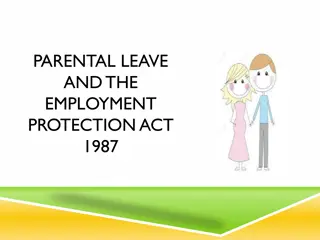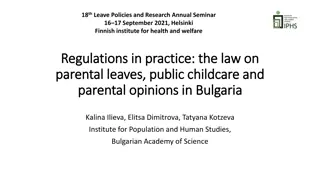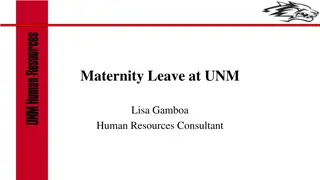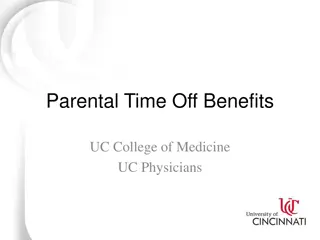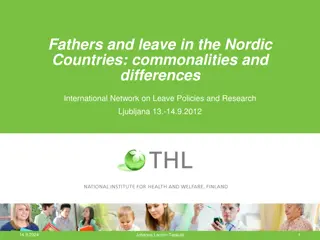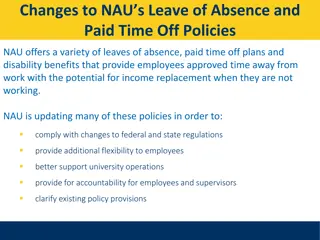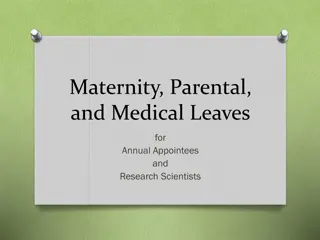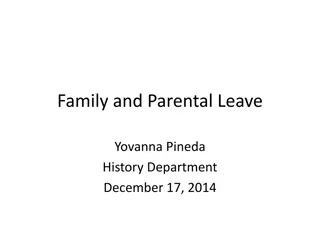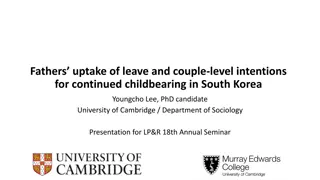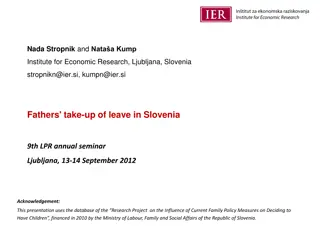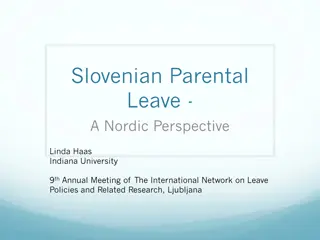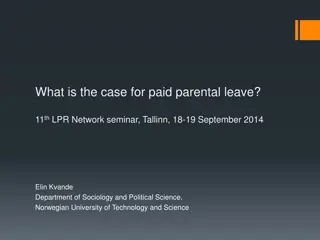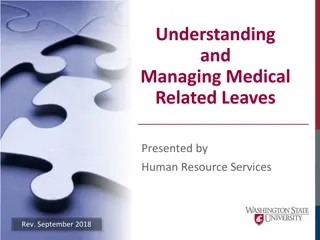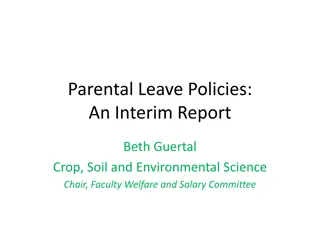Reflections on Gender and Class Issues in Parental Leave Policies in Canada
This presentation discusses the complex elements of parental leave policy design in Canada, focusing on gender and social class issues. It covers the historical changes in parental leave policies in Canada, the tri-partite system in place, and details of the parental leave benefit programs under Canada's Employment Insurance (EI) and Quebec's Parental Insurance Plan (QPIP). Recommendations are also provided based on research findings.
Download Presentation

Please find below an Image/Link to download the presentation.
The content on the website is provided AS IS for your information and personal use only. It may not be sold, licensed, or shared on other websites without obtaining consent from the author. Download presentation by click this link. If you encounter any issues during the download, it is possible that the publisher has removed the file from their server.
E N D
Presentation Transcript
Whose/who benefits? Reflections on gender and class issues in parental leave policies in Canada Andrea Doucet, Brock University Lindsey McKay, Brock University Sophie Mathieu, Universit de Montr al
Overview of Presentation 1. Brief histories 2. Canada s tri-partite system 3. Complex Elements of Leave Policy Design 4. Our Research findings: Gender 5. Our research findings: Social class 6. Recommendations (ongoing thinking on this ) 2
Brief histories Three Major periods of change in Canada 1. Mid-1990s contraction: from 300 hours to 700-then 600 hours; 67% wage compensation dropped to 55% 2. 2001: increasing duration (and later type of leave): added 25 weeks PL for 35 total expansion within a retracted envelope : poised to do this again in 2016 3. 2006 Qu bec Parental Insurance Plan created A defining feature of Parental Leave (outside of Quebec) is that it is within EI, as one of several Special Benefits. (In press) Doucet, A. and McKay, L. Parental Leave, Class Inequalities, and Caring With : An Ethics of Care Approach to Canadian Parental Leave Policy, in Caring for Children: Social Movements and Public Policy in Canada edited by R.Langford, S. Prentice, and P. Albanese, Vancouver: UBC Press 3
Canadas tri-partite system 1. Employer-sponsored leave entitlement and benefits (top- ups) Incentivized by a Federal Supplemental Unemployment Benefit (SUB) program Government-sponsored leave entitlement 14 Employment Standards Acts (13 P/T + F) Government-sponsored leave benefits 2 Programs: EI Special Benefits QPIP (Qu bec Parental Insurance Plan) 2. 3. 4
Parental leave benefit program details Canada EI Qu bec Basic Plan Qu bec Special Plan Eligibility 600 hours $2000 earnings (=170hrs at minimum wage) As of 20111 Self-employed workers Covered Waiting Period 2 weeks per couple None Weeks by wage-replacement rate (% of average earnings) Maternity 15 at 55% 18 at 70% 15 at 75% Paternity None 5 at 70% 3 at 75% Parental (shared) 35 at 55% 32 (7 at 70% + 25 at 55%) 25 at 75% Total weeks per couple 50 55 43 Adoption (shared) 35 at 55% (12 at 70% + 25 at 55%) 28 at 75% Low income (net annual income <$25,921) Up to 80% Up to 80% 5 Maximum insurable earnings (2015) 1. Under EI the self-employed must register a year in advance of the claim, reduced the amount of time devoted to their business by more than 40% because of childbirth/caring, paid contributions, and earned at least $6646 in previous 52 weeks. $524/week $49,500/year $894.22/week $70,000/year
Complex Elements of Leave Policy Design 1. Eligibility criteria 2. Job protection (and Job benefit protections (e.g. pension accrual)) 3. Duration of leave 4. Wage replacement (unpaid and paid, minimum floors and maximum ceilings ) 5. For whom? Individual versus shared entitlements Biological mothers/surrogates, non-biological mothers, fathers, adoptive parents, other carers Unemployed parents 6
Our Research Findings: Gender Numbers have shifted little over time (with exception of rising numbers of fathers in Quebec): 80 %+ fathers in Quebec ~12% of fathers in other provinces Fathers take leave when: 1. Use it or lose it Individual entitlement (QPIP) 2. Mothers do not qualify (EI) 3. Financial issues: high wage replacement rate (QPIP) or employer top-ups 4. Mothers earn more and are attached their job 7 McKay, L. and Doucet, A. Without Taking Away Her Leave : A Canadian Case Study of Couples Decisions on Fathers Use of Paid Parental Leave Fathering: A Journal of Research, Theory, and Practice About Men As Fathers, Vol.8 (3): 300-320.
Our Research on Access to PL benefits and Social Class Do Canadian parents, in Qu bec and the rest of Canada, have equal access to government- sponsored parental leave benefits (maternity, paternity, and parental leave)? McKay, L., Mathieu, S. and Doucet, A. Parental-leave rich and parental-leave poor: Inequality in Canadian Labour Market based Leave Policies Journal of Industrial Relations, 58(4), September 2016. 8
Figure 1: Proportion of Mothers Receiving Maternity and/or Parental Benefits, Canada, Qu bec, and the Rest of Canada, 2001-2013 100% 89.3% 90% 85.9% 80.5% 80% Canada 9 Provinces 70.7% 69.9% Quebec 70% 67.4% 66.3% 65.9% 65.5% 64.3% 64.2% 60% 56.4% 55.1% 61.4% 56.7% 9 50% 2001 2004 2007 2010 2013 Source: EICS, 2001, 2004, 2007, 2010 and 2013, custom tabulation, Statistics Canada
Figure 2: Class Differences: Proportion of Mothers who received Maternity and/or Parental Benefits by Household Income and Program, 2013 95% 89.8% Qu bec 9 Provinces 85.4% 74% 68.9% 43.6% 10 less than $30,000 $30,000 to $60,000 more than $60,000 Source: EICS, 2013, custom tabulation, Statistics Canada
Key findings on PL and class PL-rich and PL-poor: Growing divide between Qu bec and the ROC, and between households with different incomes We don t know who excluded mothers are. QPIP has made a difference for all mothers, especially mothers in low-income households Overall finding: With 36% of mothers excluded, and 61% of mothers in low- income households, inequality of access is a key issue to consider. 11
Which mothers? Which families? Mothers Not in Receipt of Benefits could be: Eligible and not applying Ineligible, why? Self-employed (major program difference) Insufficient hours (25% did not work enough hours to qualify in 2004, 2007, 2010, and 2013)(Sometimes due to bed rest) Parents who have paid into EI, but currently a student (ineligibility based on past 12m Never paid into EI (stay-at-home parent/uninsured work) 12
Recommendations (Our thinking-in-progress) Eligibility based on any (or longer) periods of EI contributions Paternity leave: Look to Quebec use it or lose it model: (increase time, and look at incentives for solo time for fathers); Add a flat rate minimum allowance for ineligible parents Higher floor for low-earners (100%) Benefits per child (not per birth) Other caregivers (even a cash option?) allowed for sole parents* Raise SUB program incentives ( top ups ) Better fit with childcare move away from separate approaches Short term: Look to our neighbors in Quebec Longer term: Parental leave as a care policy, not an employment policy (recognition of relationalities of work and care rather than binaries) Improve national level data collection (no official data on parents on reserve or in territories) Bring indigenous voices into this conversation Look to international examples Universal Maternity/Parental Leave Benefits using flat rate minimum allowances in Finland, Sweden, Norway & Austria Gender: Incentivizing sharing (Sweden) 13




